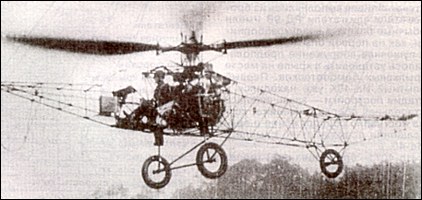
| TsAGI 1-EA 1936 |  |
 |

| TsAGI 1-EA 1936 |  |
 |
|
Basic experimental helicopter with 4-blade main rotor and four small 2-blade anti-rotation propellers (with variable pitch),installed in pairs at the ends of fuselage. Flight testes began on June 26, 1932. In July-August 1-EA was demonstrated to M.N.Tukhachevskij and Ya.I.Alksnis. M.N.Tukhachevskij suggested small series production, but A.M.Izakson (one of designers) insisted that more development is needed and resources should not be dispersed on production of 'raw' machine. Fuselage was simple frame made of steel tubes,its construction was optimized during tests. Original rectangular structure with tension wires was replaced by more solid triangular without wires. M-2 engines were selected because they did not require any special cooling in hovering regime. Because main rotor had solid blades, no special clutch was required and rotor started to spin once engines started (with compressed air). On August 14, 1932 A.M.Cheremukhin reached altitude 605m. Unfortunately, The USSR at the time was not a member of an International Aviation Federation (plus secrecy, yes!), and this record could not be formally registered. To conclude 1-EA story, it is necessary to mention that it was flown safely mostly due to well designed control system and pilot's skills of A.M.Cheremukhin. Simple straight link of main rotor to the power plant does not provide enough stability. Smallest variations in engine regime caused aircraft to move up or down, and required full attention of a pilot. One built.
Ivan P. Bratukhin, one of the pioneer figures in Soviet rotorcraft development, was a senior member of the division formed under Boris N. Yuriev at the TsAGI (Central Aero and Hydrodynamic Institute) to carry out research into problems associated with rotary-winged flight. The TsAGI's first helicopter, begun in 1928, was the 1-EA, which made its first tethered flights in August 1930. An open-framework machine, the 1-EA was powered by two 120hp M-2 rotary engines, driving a single 4-blade lifting rotor and small steering rotors at the nose and tail. Controllability of the 1-EA was poor, but it had an excellent performance and endurance and on 14 August 1932 it was flown to a record height of 605m. K.Munson "Helicopters And Other Rotorcraft Since 1907", 1968
First helicopter to fly in the Soviet Union, brain-child of Prof Boris Nikolayevich Yur’yev, who from 1909 had striven to build such machine and under Zhukovskii had been first employee of CAHI and chief architect of its original test facilities. In 1925 he organised a vertolyet (helicopter) group and in 1927 tested a 6m two-blade rotor driven by 120hp M-2. In 1928, from at least four project studies, design picked for 1-EA (Eksperimentalnii Apparat) and machine built at ZOK under G.Kh.Sabinin. Chief designer Aleksei Mikhailovich Cheryemukhin and Aleksandr Mikhailovich Izakson. Fuselage welded from M1 mild-steel tube forming spaceframe resting on tailwheel landing gear with rubber springing. Twin engines at centre with reduction and bevel gears to vertical shaft to main rotor and side-by-side pairs of 1.8m anti-torque rotors at nose and tail. Chief development task was finding best structure for main rotor blades, an all-metal blade being rejected in favour of one with dural spar, wood ribs and stringers and ply/fabric skin. Four-blade main rotor with 5° coning angle driven at 153 rpm. Cyclic and collective controls described as similar to those of today, and pedal control of nose/tail rotors from pilot seat just ahead of engines. Cheryemukhin elected to fly 1-EA himself, making first tethered run Aug 1930. No disasters and by 1932 reliable flights of up to 12 min. 1 Aug 1932 same pilot reached 160m, 3 Aug 230m, 5 Aug 285m and on 14 Aug 605m. Soviet Union not FAI member and did not announced achievement, world record remaining 18m (d'Ascanio). 1-EA continued to fly until at least 1934. Bill Gunston "The Osprey's Encyclopedia of Russian Aircraft", 2000 The single-seater helicopter had a four-bladed rotor with cyclic and collective pitch control operated by means of a hanging stick directly connected with the swash-plate. This helicopter had one outstanding feature: one small anti-torque rotor was placed at each end of its crossed metal fuselage and turned in the opposite direction from the other (i.e. they were in contra-rotation). The 1-EA was tested by Professor Cheremukhin in person and he obtained certain valuable results, though some lack of stability was revealed. After several successful flights, a crash put an end to the trials. P.Lambermont "Helicopters and Autogyros of the World", 1958 * * *
|